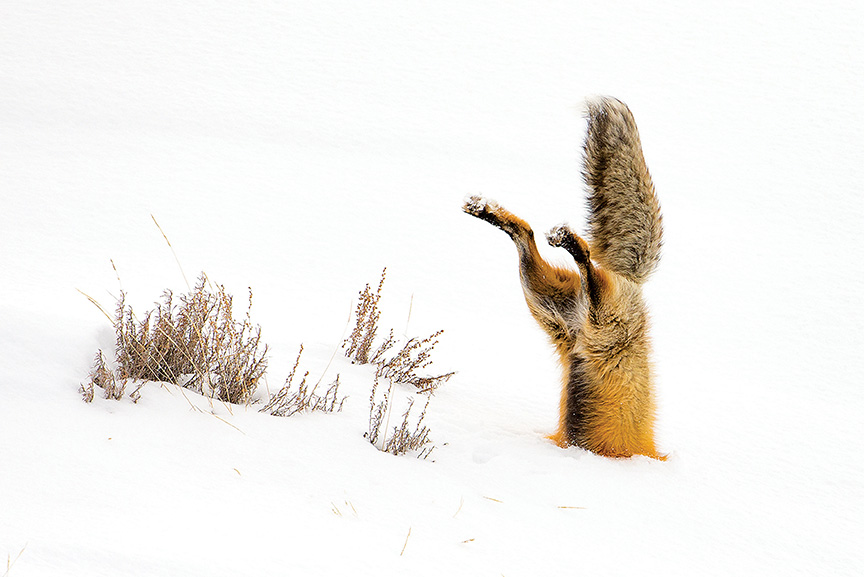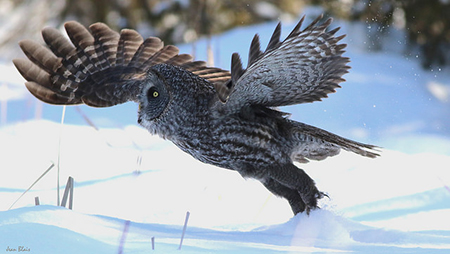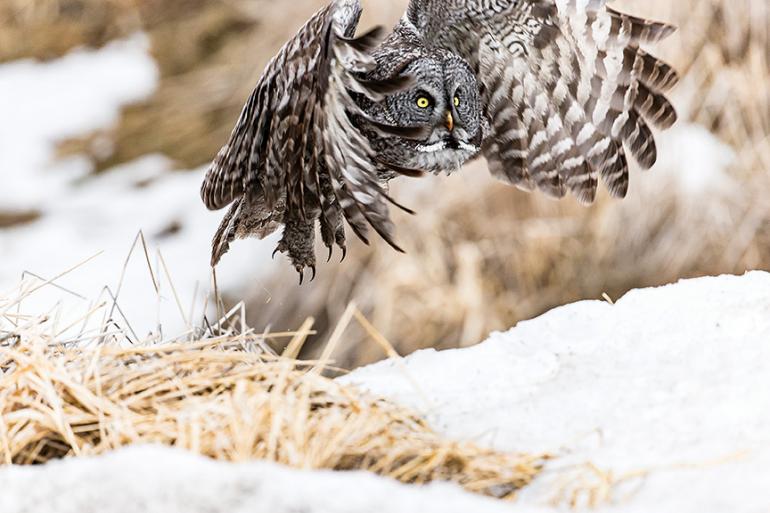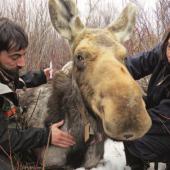Aerial Assassins
The red fox & great grey owl.
Southwest Montana’s snowy winters are great for humans who love being outdoors, but they can be brutal for animals simply trying to survive. Some species get by living under the snow, and some species stay alive by hunting those invisible critters—generally by digging, burrowing, or following critter-created tunnels.
Two skillful predators, the red fox and great grey owl, use an astonishing method to catch small rodents that are hidden beneath the snow. They execute aerial dives, plunging headfirst deep into snow with pinpoint accuracy, and often coming up with a meal. So, how the heck do they do it?
Magnetic Magician
The ability of the red fox to plunge-hunt is linked to its phenomenally acute hearing. Biologists believe that it can pick up the faint rustling of a vole or mouse under snow at a distance of up to 25 feet. In addition to its acute hearing, this cat-like predator uses stealth, agility, and a tail that can be adjusted in mid-flight to correct the trajectory of an aerial dive.
But there appears to be another reason that the red fox can successfully target rodents hidden under snow. Studies of European fox populations revealed that this predator most likely uses the Earth’s magnetic field to pinpoint the location of invisible prey. Various birds, amphibians, and other creatures rely on magneto-sensitivity for directional migration or communication, but the red fox is evidently the first animal using it to hunt.
 Does that come with fries?
Does that come with fries?
Researchers asked observers to record the direction foxes faced when they were seen snow diving. It turned out that they pointed northeast most of the time, and that they also had a much higher hunting success rate when facing this direction.
How does this work? The red fox has magneto-receptive cells in the retinas of its eyes. Humans also have a magnetic-sensitive chemical in our eyes, although scientists haven’t found evidence that that we have a sixth sense involving the Earth’s magnetic field. In the case of the fox, little is known for sure, but the Earth’s magnetic field may serve as a kind of rangefinder for the distance from the predator to its hidden prey.
In the northern hemisphere, the magnetic field tilts downward at an angle of roughly 60 degrees. One theory is that when the red fox—a northern hemisphere species—hears a tiny rustling under snow and creeps forward, it’s seeking the spot where the angle of the sound that reaches its ears matches the slope of the Earth’s magnetic field. At that spot, the prey is a fixed jump distance away from the hungry fox.
Satellite Sorcerer
Like the red fox, the great grey owl is famous for its skills as a diver—a hunting strategy that is displayed only occasionally by other owls. The size and power of this huge owl, the largest (although not the heaviest) in North America, are assets when it comes to crashing through snow a foot or more deep, that is often topped with a crust of ice. And unlike the fox, which grabs victims with its teeth, the great grey owl uses a pair of formidable talons to lock onto the small rodents that are the mainstay of its diet.
Like the red fox, the owl relies on silence while hunting—it accomplishes eerily silent flight with specially shaped wing feathers that prevent prey from hearing its approach, and at the same time, enable the owl to hear its prey. But unlike the red fox, the great grey owl doesn’t appear to use the Earth’s magnetic field to boost its success in snow diving, and it also doesn’t use echo-location (as bats do, for example), which involves emitting sounds.
 Dinner to go.
Dinner to go.
The great grey owl does, however, have another asset that boosts hunting success—it has what amounts to a highly functional satellite dish built into its large face. A circle of stiff, short feathers frames the elliptically-shaped face, and the result is a system that collects and concentrates sound on the owl’s ears. The ears are not lined up symmetrically like those of most animals; the owl hears a rodent under snow, turns its head to the sound, and tilts its face at different angles to determine the exact location of the prey.
If you have the good fortune to see a great grey owl swooping down on its hidden prey, you’ll notice that even as the bird makes a turn, it keeps its face continuously turned toward the target. When the great grey makes a vertical dive, it sometimes strikes the surface of the snow headfirst with those powerful talons crashing through immediately after. At other times, the bird raises its head a split-second before hitting the snow, and plunges its talons in first to grab the prey.











